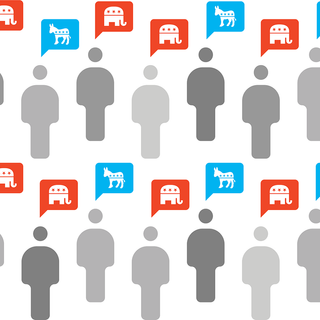Democratic presidential nominee Joe Biden leads Donald Trump in the bulk of opinion polls, with just 50 days until the November election.
But poll-based forecasts were widely maligned after the 2016 election, and with some justification: Trump won when the bulk of the polling insisted he would not.
So, can 2020 polling be believed? Or, like 2016, are the polls substantially underestimating Trump’s support? Our analysis suggests Trump’s chances of winning are not small — as a naive reading of the polls might suggest — but closer to one in three.
Are the polls substantially underestimating Trump’s support? Our analysis suggests Trump’s chances of winning are not small — as a naive reading of the polls might suggest — but closer to one in three.
In US presidential elections, states are allocated delegates to the electoral college roughly proportional to their populations. In almost all states, the candidate winning the most votes wins that state’s entire slate of delegates. The candidate winning a majority of the electoral college — 270 votes or more — wins the election.
For the fifth time in US history, the 2016 election produced a mismatch between the national vote and the electoral college outcome. Trump won efficiently, with thin margins in key states, converting 46 per cent of all votes cast into 56.5 per cent of the electoral college. Conversely, Hillary Clinton’s vote tended to be concentrated in big states such as California and New York.
Accordingly, election analysts focus less on national polls and more on polls from “swing states”, those states that have swung between the parties. These will decide the 2020 election.
Biden has poll leads over Trump in several swing states won by Obama in 2008 and/or 2012, but won by Trump in 2016: Florida, Michigan, North Carolina, Pennsylvania and Wisconsin. These five states are worth 90 electoral college votes. Biden also leads the polls in Arizona (11 electoral college votes), a state won by Republicans in 16 of the past 17 presidential elections.
If we take recent averages of polls in these states at face value, then Trump would lose 101 of the electoral college votes he won in 2016 and be soundly defeated.
An in-depth review of 2016 polling found that an unusually large number of late-deciders strongly favoured Trump, inducing error in polls fielded even late in the campaign. This year’s polling shows just the opposite, with historically low levels of undecided voters.
But state polls performed poorly in 2016, systematically underestimating Trump’s support. His margin over Clinton was underestimated by more than five points in North Carolina (5.3), Minnesota (5.7), Ohio (6.9) and Wisconsin (7.2).
Polls in 2016 ultimately picked the wrong winner in four cases: Florida, Pennsylvania, Michigan and Wisconsin, all Obama-to-Trump switches, and together worth 75 electoral college votes — more than enough to lead to the incorrect prediction that Clinton would win.
An in-depth review of 2016 polling found that an unusually large number of late-deciders strongly favoured Trump, inducing error in polls fielded even late in the campaign. This year’s polling shows just the opposite, with historically low levels of undecided voters. It seems most Americans have firm views about Trump one way or the other, also reflected in his extremely stable approval ratings.
A more pressing issue for election polling is modelling who will turn out and have their votes counted. In 2016, Trump slowed the trend towards whites becoming a smaller portion of the US electorate, mobilising white voters who ordinarily have a low propensity to turn out (including non-urban voters and those with lower levels of education).
The 2018 midterm elections saw a massive counter-mobilisation, with century-high levels of midterm turnout, and the non-white proportion of the electorate surging to record levels. This year’s election will likely see high levels of engagement from both sides of politics, with Trump back on the ballot — and potentially a surge in turnout unseen in decades — further threatening the accuracy of 2020 election polls.
The perils of pre-election polling: is the 2020 election much closer than the polls suggest?

Latest state-level poll averages imply Biden would handily win the election with an electoral college victory of 334 to 204.
But if 2020 polls are as wrong as they were in 2016, then Biden’s leads in at least North Carolina and Wisconsin are incorrect, implying a still comfortable electoral college result of 309-229.
In recent weeks we have seen Biden’s leads in poll averages from Pennsylvania, New Hampshire and Florida also smaller than the 2016 poll error in those states. Florida would be especially consequential given its 29 electoral college votes, the third-biggest state in the electoral college.
If Trump wins these states, and 2016 results are replicated elsewhere, then he narrowly wins with 282 electoral college votes.
Given the statistical range of poll errors in 2016 — and assuming they reoccur in 2020 — today’s polling implies Trump has roughly a one in three chance of being re-elected.
On top of this is the very real prospect polls could actually be an accurate reflection of voters’ intentions, but the COVID-19 pandemic and uncertainty over how and where to vote disrupts the translation of preferences into counted ballots. Election administration is a state and local matter in the US, with tremendous variation in the use and ease of pre-polling or voting by mail.
Litigation is already underway in almost every state over various aspects of the conduct of the 2020 election.
The polls could well produce incorrect forecasts of the final, certified election results, but for reasons far downstream from more typical sources of poll error. Poll errors of the magnitudes seen in 2016 could be likely, albeit for perhaps different reasons than those seen in 2016.
All this suggests considerable caution should be exercised in relying on polls to forecast the 2020 election and that poll-based forecasts of the result are almost surely overconfident, with Trump’s chances of re-election considerably higher than that suggested by polling to date.






